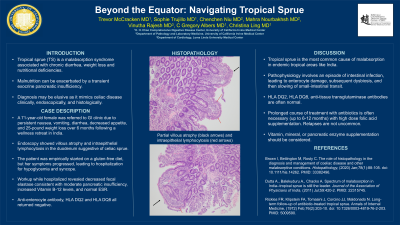Monday Poster Session
Category: Small Intestine
P3230 - Beyond the Equator: Navigating Tropical Sprue
Monday, October 28, 2024
10:30 AM - 4:00 PM ET
Location: Exhibit Hall E

Has Audio
- TM
Trevor McCracken, MD
University of California Irvine
Orange, CA
Presenting Author(s)
Trevor McCracken, MD1, Sophie Trujillo, DO2, Vinutha Rajesh, MD3, C Gregory Albers, MD4, Christina Ling, MD4
1University of California Irvine, Orange, CA; 2University of California Irvine, Irvine, CA; 3Loma Linda University Medical Center, Loma Linda, CA; 4University of California, Irvine, Orange, CA
Introduction: Tropical sprue (TS) is a malabsorption syndrome associated with chronic diarrhea, weight loss and nutritional deficiencies. It may masquerade as a variety of other diseases, particularly celiac disease.
Case Description/Methods: A 71-year-old female was referred to GI clinic due to persistent nausea, vomiting, diarrhea, decreased appetite, and 25-pound weight loss over 6 months following a wellness retreat in India. Initial laboratory and imaging workup was unremarkable for malignancy. Endoscopy showed villous atrophy and intraepithelial lymphocytosis in the duodenum suggestive of celiac sprue. Despite being on a gluten-free diet, her symptoms included severe malnutrition and hypoglycemia resulting in syncope and hospitalization. Her workup was notable for decreased fecal elastase consistent with moderate pancreatic insufficiency, increased Vitamin B-12 levels, and normal ESR. Biopsies were reviewed with pathology, but the diagnosis was inconclusive. Patient underwent G-tube placement for enteral feeding given that she developed severe malnutrition. The differential included autoimmune enteropathy, common variable immunodeficiency, giardiasis, and TS. Anti-enterocyte antibody and HLA DQ2/DQ8 were negative. Given her travel history, TS was suspected so she was treated with empiric tetracycline, high dose folic acid, pancreatic enzymes, and zinc supplementation. Within two weeks, her symptoms improved significantly confirming the diagnosis of TS.
Discussion: TS is the most common cause of malabsorption in endemic tropical areas like India and we suspect that our patient contracted TS during her prolonged stay. The pathophysiology involves an episode of intestinal infection, leading to enterocyte damage, subsequent dysbiosis, and then slowing of small-intestinal transit. TS can mimic celiac sprue, clinically, endoscopically, and histologically. In addition to a thorough history and discussion with Pathology regarding biopsy results, testing for anti-enterocyte antibody and HLA DQ2/DQ8 was essential for an accurate diagnosis. In our case, celiac disease was unlikely given that both HLA DQ2/DQ8 and TTG IgA were normal. Most patients respond well to treatment, but a prolonged course for up to 6-12 months may be needed to prevent relapse. Notably, malnutrition in TS is exacerbated by transient pancreatic insufficiency caused by damage to villi, so prompt initiation of pancreatic enzymes in addition to tetracycline and high dose folic acid is crucial and likely would have prevented hospitalization.
Disclosures:
Trevor McCracken, MD1, Sophie Trujillo, DO2, Vinutha Rajesh, MD3, C Gregory Albers, MD4, Christina Ling, MD4. P3230 - Beyond the Equator: Navigating Tropical Sprue, ACG 2024 Annual Scientific Meeting Abstracts. Philadelphia, PA: American College of Gastroenterology.
1University of California Irvine, Orange, CA; 2University of California Irvine, Irvine, CA; 3Loma Linda University Medical Center, Loma Linda, CA; 4University of California, Irvine, Orange, CA
Introduction: Tropical sprue (TS) is a malabsorption syndrome associated with chronic diarrhea, weight loss and nutritional deficiencies. It may masquerade as a variety of other diseases, particularly celiac disease.
Case Description/Methods: A 71-year-old female was referred to GI clinic due to persistent nausea, vomiting, diarrhea, decreased appetite, and 25-pound weight loss over 6 months following a wellness retreat in India. Initial laboratory and imaging workup was unremarkable for malignancy. Endoscopy showed villous atrophy and intraepithelial lymphocytosis in the duodenum suggestive of celiac sprue. Despite being on a gluten-free diet, her symptoms included severe malnutrition and hypoglycemia resulting in syncope and hospitalization. Her workup was notable for decreased fecal elastase consistent with moderate pancreatic insufficiency, increased Vitamin B-12 levels, and normal ESR. Biopsies were reviewed with pathology, but the diagnosis was inconclusive. Patient underwent G-tube placement for enteral feeding given that she developed severe malnutrition. The differential included autoimmune enteropathy, common variable immunodeficiency, giardiasis, and TS. Anti-enterocyte antibody and HLA DQ2/DQ8 were negative. Given her travel history, TS was suspected so she was treated with empiric tetracycline, high dose folic acid, pancreatic enzymes, and zinc supplementation. Within two weeks, her symptoms improved significantly confirming the diagnosis of TS.
Discussion: TS is the most common cause of malabsorption in endemic tropical areas like India and we suspect that our patient contracted TS during her prolonged stay. The pathophysiology involves an episode of intestinal infection, leading to enterocyte damage, subsequent dysbiosis, and then slowing of small-intestinal transit. TS can mimic celiac sprue, clinically, endoscopically, and histologically. In addition to a thorough history and discussion with Pathology regarding biopsy results, testing for anti-enterocyte antibody and HLA DQ2/DQ8 was essential for an accurate diagnosis. In our case, celiac disease was unlikely given that both HLA DQ2/DQ8 and TTG IgA were normal. Most patients respond well to treatment, but a prolonged course for up to 6-12 months may be needed to prevent relapse. Notably, malnutrition in TS is exacerbated by transient pancreatic insufficiency caused by damage to villi, so prompt initiation of pancreatic enzymes in addition to tetracycline and high dose folic acid is crucial and likely would have prevented hospitalization.
Disclosures:
Trevor McCracken indicated no relevant financial relationships.
Sophie Trujillo indicated no relevant financial relationships.
Vinutha Rajesh indicated no relevant financial relationships.
C Gregory Albers: Nestle Health – Speakers Bureau. Phathom Pharmaceuticals – Speakers Bureau. Salix Pharmaceuticals – Speakers Bureau.
Christina Ling indicated no relevant financial relationships.
Trevor McCracken, MD1, Sophie Trujillo, DO2, Vinutha Rajesh, MD3, C Gregory Albers, MD4, Christina Ling, MD4. P3230 - Beyond the Equator: Navigating Tropical Sprue, ACG 2024 Annual Scientific Meeting Abstracts. Philadelphia, PA: American College of Gastroenterology.
